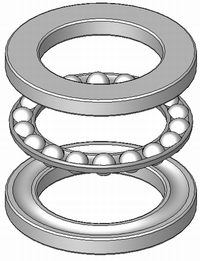
Photo from wikipedia
Purpose This paper aims to present a numerical model to investigate the mixed lubrication performances of journal-thrust coupled bearings (or coupled bearings). Design/methodology/approach The coupled hydrodynamic effect (or coupled effect)… Click to show full abstract
Purpose This paper aims to present a numerical model to investigate the mixed lubrication performances of journal-thrust coupled bearings (or coupled bearings). Design/methodology/approach The coupled hydrodynamic effect (or coupled effect) between the journal and the thrust bearing is considered by ensuring the continuity of the hydrodynamic pressure and the flow field at the common boundary. The mixed lubrication performances of the coupled bearing are comparatively studied for the cases of considering and not considering coupled effect. Findings The simulated results show that the hydrodynamic pressure distributions for both the journal and thrust bearing are modified due to the coupled effect. The decreased load capacity of the journal bearing and the increased load capacity of the thrust bearing can be observed when the coupled effect is considered. And the coupled effect can facilitate in reducing the asperity contact load for both the journal and thrust bearing. Additionally, the interaction between the mixed lubrication behaviors, especially for the friction coefficient, of the journal and the thrust bearing is significant in the elastohydrodynamic lubrication regime, while it becomes weak in the mixed lubrication regime. Originality/value The developed model can reveal the mutual effects of the mixed lubrication behavior between the journal and the thrust bearing.
Journal Title: Industrial Lubrication and Tribology
Year Published: 2019
Link to full text (if available)
Share on Social Media: Sign Up to like & get
recommendations!